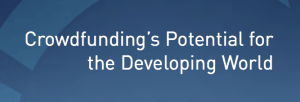 Crowdfunding exploded in 2013, and so revealed its massive potential in a way that’s impossible to ignore. Not least December’s ‘The Rise of Future Finance” and the World Bank Report which preceded it. These together left no doubt that crowdfunding has become an established part of the mainstream astonishingly quickly, and has the potential to grow to a position to augment or even dominate it. An unlikely prospect – until you start to think about what web technology has done in so many other areas.
Crowdfunding exploded in 2013, and so revealed its massive potential in a way that’s impossible to ignore. Not least December’s ‘The Rise of Future Finance” and the World Bank Report which preceded it. These together left no doubt that crowdfunding has become an established part of the mainstream astonishingly quickly, and has the potential to grow to a position to augment or even dominate it. An unlikely prospect – until you start to think about what web technology has done in so many other areas.
While many are trying to spot (or become) the ‘Google of Crowdfunding’ it’s increasingly clear there isn’t going to be one. Or two. It’s increasingly clear that crowdfunding is becoming a new dimension to the economy rather than just a tool or a sector within it.
While traditional banks show little or no sign of regaining a conscience (typically preferring window dressing and kicking it into the long grass) crowdfunding has been quietly growing at up to 600% – and showing that it can reach not only the places that traditional finance could reach when it was really available, but many others it couldn’t.
So if this is not just big, but new DNA as well, how is it so different and what can we expect to see in 2014 and the years ahead?
- The “Long Tail” – and Three Million SufferersTalking of DNA, “Black Bone Disease” was the first genetic disease ever identified but as a ‘rare’ disease there is still no approved treatment, although there is a good candidate now in trials thanks to crowdfunding. (And if you think this is a metaphor for the economy and crowdfunding then you may just be on to something) It turns out that there are over three million people in the UK alone who suffer from a “rare” disease – this being an unfamiliar use of the word “rare” for most people. (The definition of a “rare” disease is one from which fewer that 100,000 people suffer) With “smart” capital always seeking the maximum ROI, and this driving medicine and the pharmaceutical industry worldwide, finding treatments for these sufferers is so far down the list of priorities as compared with much more profitable drugs and procedures as to have no chance of ever being funded.This is why Dr Nick Sireau and the AKU Society’s campaign on Indiegogo is so significant and groundbreaking. It’s a prime example of a “small” scattered group of people enabled to come together around something (or someone) they care about to overcome a previously insuperable hurdle. In this case they’ve raised $120,000 – enough to get a clinical trial started – and a little more.
Not only does it point the way for other people and groups with “rare” diseases which our current economic models cannot reach (which has not escaped the attention of many such societies) but also to the many, many instances of the “long tail” of needs and wants which current sledgehammer, mono-culture economics cannot crack.
Those currently trying to figure our how to make their first million IN crowdfunding would probably be better off looking (as Amazon did) at the “long tail” to identify the audience for which they could create something that’s wanted or needed WITH crowdfunding.
- The democratisation of job creation
 While crowdfunding has often been hailed as the remover of gatekeepers heralding the “democratisation of finance,” it’s increasingly clear that it has even greater potential to create new economics and new freedoms. Together with the technology changes which have preceded it (especially The Internet and cheaply available laptops, etc.) it’s making a new kind of self-sufficiency a real option. For the first time in many centuries it’s becoming possible for people to create their own jobs – roll-their-own-role. To start a business you no longer need a gatekeeper to apply their inevitably conventional wisdom and dole out their capital on their terms. So long as you can find a small crowd sufficiently interested to come up with the money, you can create your own micro-business, perhaps employing others, but most importantly of all yourself. You can do something that actually interests you.Crucially, though, this means that you are no longer so utterly dependent on the state or big corporations to create increasingly poorly paying jobs in your area. With the right idea and enough work and ingenuity you have a new option to roll-your-own-role. A new kind of independence, and a new option for us all. Up to and including school leavers who, it turns out, are remarkably well adapted (as a generation) to this new environment, having grown up in it.
While crowdfunding has often been hailed as the remover of gatekeepers heralding the “democratisation of finance,” it’s increasingly clear that it has even greater potential to create new economics and new freedoms. Together with the technology changes which have preceded it (especially The Internet and cheaply available laptops, etc.) it’s making a new kind of self-sufficiency a real option. For the first time in many centuries it’s becoming possible for people to create their own jobs – roll-their-own-role. To start a business you no longer need a gatekeeper to apply their inevitably conventional wisdom and dole out their capital on their terms. So long as you can find a small crowd sufficiently interested to come up with the money, you can create your own micro-business, perhaps employing others, but most importantly of all yourself. You can do something that actually interests you.Crucially, though, this means that you are no longer so utterly dependent on the state or big corporations to create increasingly poorly paying jobs in your area. With the right idea and enough work and ingenuity you have a new option to roll-your-own-role. A new kind of independence, and a new option for us all. Up to and including school leavers who, it turns out, are remarkably well adapted (as a generation) to this new environment, having grown up in it.
No doubt some of these micro-businesses will grow up into “SMEs” or even mega enterprises BUT this is NOT THE POINT! The point is twofold: Firstly, a new freedom and a realistic option for many; Secondly many, many, many new small businesses serving the real needs of real people – which together can do more than any multinational corporation, as well as be more creative and flexible than a corporation could dream of. Many of these business exist for – and are anchored in – local communities.
- Localism and Micro-localismTalking of communities, as the corporate world (banks, energy, etc) become increasingly self obsessed, ROI driven, and increasingly remote and removed from the people they grew up to serve (not to mention those they employ to serve them) communities are starting to stir. They’re beginning to wake up to the fact that they too are no longer shackled to corporate capital or government handouts. Increasingly communities are “doing for themselves,” from buying up the local shop or pub to saving it from extinction to creating new playgrounds and other amenities. Expect to see biomass and other self-generation projects springing up, creating clean, green energy where it’s needed, while making communities increasingly independent of the voracious energy companies… and much more. But perhaps more than anything else…
- An explosion of Creativity
 PowerUp 3.0 Plane is a great project as well as another great metaphor for crowdfunding. It’s something that would never have reached the labs of the toy companies (or anyone else), let alone made it out of them. Like crowdfunding it’s based on something that is close to being able to really fly all by itself, but just needs that extra push – and a little direction – to stay aloft. It is a kit that powers and propels an ordinary paper plane and makes it steerable via something you already have: your mobile phone. And it’s a lot of fun.In the unlikely event that this idea had been taken remotely seriously by a big toy or games company it could not have emerged looking anything like this, and probably not at all.
PowerUp 3.0 Plane is a great project as well as another great metaphor for crowdfunding. It’s something that would never have reached the labs of the toy companies (or anyone else), let alone made it out of them. Like crowdfunding it’s based on something that is close to being able to really fly all by itself, but just needs that extra push – and a little direction – to stay aloft. It is a kit that powers and propels an ordinary paper plane and makes it steerable via something you already have: your mobile phone. And it’s a lot of fun.In the unlikely event that this idea had been taken remotely seriously by a big toy or games company it could not have emerged looking anything like this, and probably not at all.
At this price point where’s the profit in it for a big, established company with lots of overhead and other ways to deploy their capital? How much better to make a “proper” fuselage (which we can put our logo on) and a “proper” remote control (which we can also put our logo on) and add a charger, etc. We can put it in a nice big box and sell it at a much higher price point ensuring there’s room enough for plenty of margin for us and everyone else down the food chain.
We are already seeing a huge explosion of such devices that would not – could not – otherwise have ever seen the light of day. Not just toys and gadgets either. Some really innovative and useful medical and other devices – and more creativity, and R&D, than any known corporate could shake a stick at!
Much of this will be focussed on mobile phones – which itself will undoubtedly be the focus of much crowdfunded creativity in the coming year – and (to a lesser extent) tablets at first, not least because of the wealth of unexplored apps and other possibilities created by that super-computer-in-disguise that you carry around, talk into and play games on. But as the penny drops we will also see unthought-of ideas taking flight and some appearing in unexpected places, including our beds.
There will be some other easier to predict trends too. An epidemic of “instant-experts” who have a long history and deep understanding of crowdfunding (until you ask them about it, or it’s roots in social media) is inevitable and already starting to appear. Massive growth is a given.
But where next? 2014 will be the year of Crowdonomics. This is just the beginnings – the first cracks – of a greater change then any we’ve yet seen. People used to laugh aloud – or more often just look at me strangely – twenty years ago when I told them that this Internet thing that they’d barely heard of would not be confined to geeks but would first become a part of the mainstream, and then would become the mainstream.
Most of what we’ve seen since then has been applying that tech to power existing models. Crowdfunding is difference in that it’s already showing it’s potential to fundamentally disrupt the most fundamental of models: by changing ‘who decides’, and how. Who decides the way businesses, products and services are created and paid for, and how people derive a livelihood from this. Or to put it another way: The economy. Are we seeing the first tender tendrils of Crowdonmics? 2014 will tell it’s owns story.
This article was shared with Crowdfund Insider by Barry E. James of The Social Foundation and The Crowdfunding Centre.

